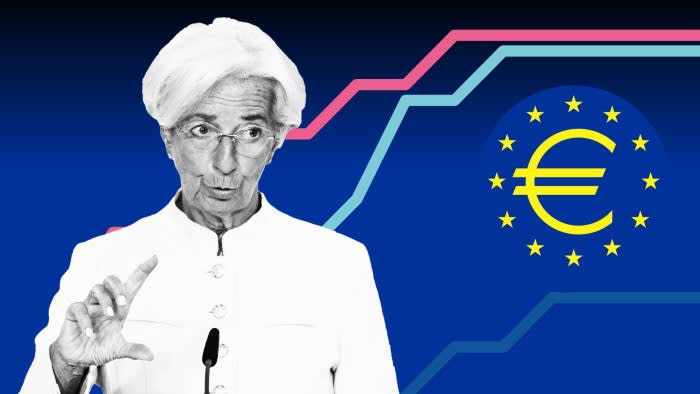The euro zone will get a much-needed economic boost on Thursday, when the European Central Bank is expected to cut interest rates for the first time in almost five years.
The size of the boost will depend on how much borrowing costs fall further, but persistently high inflation, driven by fast wage growth, could limit the number of rate cuts, analysts say.
With markets considering a first rate cut as a given, investors will be keenly looking for clues from ECB President Christine Lagarde on the future path of monetary policy.
By lowering interest rates again, the bank will revive housing markets, business investments and consumer spending. The ECB raised deposit rates to a record 4 percent last year, clamping down on economic activity to tackle the biggest price rise in a generation.
“Lower interest rates matter,” said Holger Schmieding, chief economist at German bank Berenberg. “The financial markets are well aware that this is coming, but the news that the ECB has started cutting rates could pick up [the] attract the attention of households and businesses and improve sentiment.”
The eurozone economy already showed tentative signs of recovery in the first three months of this year, as the bloc’s gross domestic product rose 0.3 percent from the previous quarter, ending a year of stagnation .
The growth spurt mainly reflected the waning of the energy and food price shock caused by Ukraine’s large-scale invasion of Ukraine and a recovery in global trade, Schmieding said.
But he added that anticipation of interest rate cuts had also helped reduce the cost of mortgages and business loans. “This will lead to a trough in housing markets and a recovery in housing construction, and should help investment recover as we expect this year.”
In Germany, house prices fell by 10 percent after the ECB started raising interest rates in 2022. But they are stabilizing this year after 10-year mortgage rates fell from nearly 4 percent last October to below 3.2 percent, according to mortgage broker Dr. Klein. .
“The more favorable interest rates since then have led to a noticeable increase in demand for mortgage financing, and the market has seen a significant rebound since then,” said Michael Neumann, Dr Klein’s head of private clients.
Marc van der Lee of the Dutch Association of Real Estate Agents predicted that house prices in the Netherlands would rise to record highs in the second quarter, mainly due to rising wages and a housing shortage, but would also be offset by lower mortgage costs.

In terms of further steps after Thursday’s meeting, the problem for Lagarde is that the steady decline in inflation from its peak of more than 10 percent in 2022 has been interrupted. Data published last week showed annual price growth accelerated again to 2.6 percent in May, up from 2.4 percent a month earlier.
The eurozone’s unexpectedly strong labor market also keeps price pressures high: collective wage growth rose again to a record pace of 4.7 percent in the first quarter and unemployment in the bloc fell to a new low of 6.4 percent in April.
Most economists think the recent strong data means the ECB will have to slightly increase both its 2.3 percent inflation forecast for this year and its 0.6 percent GDP growth forecast.
Combined with signs that the Federal Reserve is unlikely to cut rates this year – if at all – due to the strong US economy, investors have scaled back their bets to a cut of less than three quarter points by the ECB this year. year.
The timing of this week’s rate cut will be unusual for the ECB because it typically only launches such monetary easing in response to a crisis, such as after the collapse of Lehman Brothers in 2008 or when Greece needed a series of bailouts in 2011.
Even the ECB’s last rate cut in September 2019 was a response to weakening growth and inflation falling below the 2 percent target.
“They aim for an improving situation, rather than a worsening one,” said Paul Hollingsworth, chief European economist at French bank BNP Paribas. “This means they will be in no rush to cut rates further, making another cut in July unlikely and prompting them to cut rates only once a quarter.”
Influential members of the ECB’s rate-setting governing board have already hinted that they expect gradual easing, with only two further rate cuts likely this year.
ECB chief economist Philip Lane told the Financial Times last month that interest rates were likely to “fall somewhat” over the course of the year while remaining in “restrictive territory,” which most economists believe means they will remain above 3 percent to stay.
Dutch central bank chief Klaas Knot told an event in London last week that based on the ECB’s latest forecasts, its models showed that “optimal policy by the end of the year would be broadly in line have been with three to four interest rate cuts.”
In order for inflation to fall to the ECB’s target of 2 percent next summer, it is counting on a combination of slowing wage growth, increasing employee productivity and shrinking company profit margins.
If these trends don’t materialize and inflation remains uncomfortably high, Hollingsworth says rate setters “may have to pause after the first few cuts.”
Faced with this uncertainty about the economic outlook, Lagarde is widely expected to resist giving a big signal on the likely policy path, allowing the bank to maintain maximum flexibility on the size of rate cuts for as long as possible.

